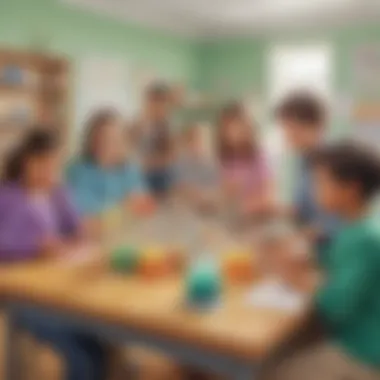Exploring Density: Fun Experiments for Kids


Intro
Understanding the concept of density is vital for young scientists. Density refers to how much mass is contained in a given volume. It is one of the basic principles in physics and chemistry, affecting everything from floating to sinking in liquids to the behavior of different materials. This guide aims to connect children aged 6-12 with engaging experiments that demonstrate density in real-world scenarios. These hands-on activities not only clarify the concept but also inspire curiosity and a desire to learn more about the sciences.
Science Fun Facts
There are many intriguing aspects of density that can excite young minds. Here are some interesting fun facts and trivia that pair well with experiments:
- Did you know? The density of water is 1 gram per cubic centimeter at room temperature. Objects with a density greater than water sink, while those with a density less float.
- Quirky Science Story: Archimedes, a Greek mathematician, discovered the principle of buoyancy while taking a bath. He realized that the amount of water displaced was equal to the volume of the part of his body submerged.
- Amazing Science Record: The densest naturally occurring element is osmium, with a density of about 22.59 grams per cubic centimeter. This makes it useful in various industrial applications but also quite rare.
- Thought-Provoking Question: What would happen if two objects with the same shape but different materials were placed in water? Would they sink or float? Why does density play a role in this?
Discover the Wonders of Science
Science is all around, and density helps explain many everyday occurrences. Here are some ways to explore density further:
- Educational Videos and Animations: Platforms like Britannica offer visual explanations for complex concepts like density.
- Interactive Learning Tools: Online resources provide simulate density experiments, allowing kids to see results instantly.
- Real-Life Applications: From cooking to manufacturing, understanding density aids in various choices and products.
Science Quiz Time
Assessing comprehension of density can be fun with quizzes. Here are some interactive quiz ideas to involve youngsters:
- Multiple Choice Questions: Questions can be created to ask about what floats or sinks in water based on given densities.
- Brain Teasers and Puzzles: Simple riddles based on density can challenge young minds creatively.
- Learning Through Gamification: Using apps that incorporate density concepts through game elements can enhance retention and interest.
Science Experiment Showcase
Experiments are crucial for understanding density. Below are some fun activities:
Fun and Engaging Experiments
- Layered Liquids: Create a colorful density tower using liquids of different densities like honey, water, and vegetable oil.
- Eggs in Water: Place eggs in fresh water and salt water to see how they behave. The density of saltwater makes an egg float while it sinks in fresh water.
Step-by-Step Instructions
- For Layered Liquids:
- For the Egg Experiment:
- Gather clear liquids of different densities and food coloring.
- Layer the liquids in a clear container, watching them settle.
- Fill two containers with water.
- Add salt to one until it dissolves.
- Introduce an egg to both containers and observe.
Materials List
- Clear container
- Honey
- Water
- Vegetable oil
- Food coloring
- Eggs
- Salt
Safety Tips and Precautions
- Always have an adult supervise when conducting experiments.
- Ensure children do not consume any materials from the experiments.
Density is a foundational concept that influences many areas of science and everyday life, making it essential for young minds to explore.
Understanding Density
Density is a fundamental property of matter. It forms the basis for various scientific discussions and experiments. Understanding density helps young scientists grasp essential concepts in physics and chemistry. It fosters a deeper appreciation of the materials around them. Young minds can explore how different substances interact in terms of weight and volume.
What is Density?
Density refers to the mass of an object relative to its volume. Mathematically, density is expressed as:
[ D = \fracmV ]
where (D) is density, (m) is mass, and (V) is volume. This relationship provides a clear framework for understanding how materials are classified. For example, denser materials sink, while less dense ones float. Understanding this distinction gets to the heart of scientific inquiry, setting a foundation for future learning.


Why Density Matters
Recognizing the relevance of density in everyday life is crucial. It appears in numerous applications, from floating boats to the functioning of everyday items like ice and water.
A few points of interest include:
- Buoyancy: Density explains why some objects float while others sink.
- Material Selection: Engineers and designers consider density when choosing materials for construction or manufacturing.
- Environmental Studies: Density plays a role in understanding pollutants in water bodies.
Thus, it becomes evident that density is not merely an abstract concept; it holds profound implications in real-world scenarios.
The Formula for Density
Density Equation
The density equation incorporates the mass and volume to provide insights into material properties. Through this equation, students can manipulate values for mass and volume, observing how changes impact density. Learning the formula serves as a stepping stone to more complex calculations, enhancing overall mathematical skills. Furthermore, this equation illustrates the direct relationship between mass and volume, serving as a springboard for deeper exploration.
Units of Measurement
Units of measurement for density are essential for scientific accuracy. Commonly, density is expressed in grams per cubic centimeter (g/cm³) or kilograms per cubic meter (kg/m³). Choosing the appropriate unit ensures clarity and precision in communication. Familiarity with these units helps young scientists conduct experiments correctly, promoting a standardized way of discussing findings. A proper grasp of these units also enhances understanding of how density varies across different materials.
Types of Density
Understanding different types of density is crucial for grasping how various materials interact with each other in the physical world. Each type of density provides insights into the behavior of substances under different conditions. By learning about mass density, volume density, and relative density, young scientists can develop a well-rounded understanding of density as a scientific concept. This knowledge can enhance their problem-solving skills and curiosity in science, leading them to explore further.
Mass Density
Mass density refers to the amount of mass contained in a given volume of a substance. It is a measure of how tightly matter is packed together. The formula for mass density is:
Mass density is typically expressed in units like grams per cubic centimeter (g/cm³) or kilograms per cubic meter (kg/m³), depending on the circumstances. This concept is essential for various applications, such as determining whether an object will float or sink in a fluid. For example, if the mass density of an object is greater than the mass density of the fluid it is placed in, it will sink. If it is lower, the object will float.
Volume Density
Volume density, while closely related to mass density, focuses more on how much space a certain mass occupies rather than just the mass itself. Volume density is particularly useful when discussing gases and liquids, where the amount of space taken up can vary significantly. In practical terms, volume density can help explain why a balloon filled with air is lighter than an equivalent balloon filled with water.
The calculation for volume density can be expressed similarly to mass density but often focuses on how different materials like liquids and gases behave under pressure and temperature variations. Understanding volume density can aid young scientists in realizing everyday phenomena, such as why hot air rises or why ice floats.
Relative Density
Relative density, also known as specific gravity, is a comparison of the density of a substance to the density of a reference material, usually water. The formula can be expressed as:
When relative density is calculated, it has no units. A substance with a relative density less than 1 will float in water, whereas a relative density greater than 1 will sink. This concept is essential for understanding buoyancy and flotation. For instance, if a young scientist wants to predict whether an object will sink or float in water, they can use its relative density as a quick reference.
Conducting Density Experiments
Conducting density experiments is a crucial part of understanding the concept of density itself. Through experimentation, young scientists can visualize and grasp how different materials behave in relation to their density. Hands-on activities enable students to engage with scientific principles in a tangible way, promoting curiosity and encouraging further exploration of the topic. Density experiments also help in fostering critical thinking skills and the scientific method, as students create hypotheses and analyze results.
Preparation for Experiments
Required Materials
The required materials play a significant role in the successful execution of density experiments. For these activities, common materials such as water, various liquids (like vegetable oil and syrup), measuring cups, and small objects (like marbles or pieces of fruit) are used.
These materials are beneficial because they are usually readily available and inexpensive, making them accessible for young scientists and their families. A unique feature of these materials is that they allow for direct observation of density in action when items float or sink. This promotes hands-on learning and a practical understanding of the concept.
Safety Precautions
Safety precautions are essential to guarantee a secure and enjoyable experience for all young scientists involved in density experiments. Basic safety measures, including using protective eyewear and ensuring that work areas are clean and organized, cannot be overlooked.
Such precautions are critical as they help in preventing accidents, especially while handling liquids that may spill. A unique feature of incorporating safety precautions is that it teaches children the importance of safety in scientific work, encouraging responsible practices from a young age.


Simple Density Experiment with Liquids
Experiment Steps
The experiment steps in a simple density experiment with liquids guide young scientists through the process of mixing different liquids and observing their behaviors. The procedure typically involves pouring different liquids into a clear container and noting how they stack based on their density.
This structured approach is advantageous as it provides clear directions, ensuring that children can follow along easily. A unique feature of these steps is that they allow for immediate visual feedback, helping to reinforce the concept of density interactively.
Expected Results
Expected results in this experiment include observing which liquids float on or sink below each other. Generally, liquids with lower density will float on those with higher density. This component is important as it guides the child's understanding of the outcome of their experiment, forming a direct connection between their actions and the physical principles at play.
The unique feature of sharing expected results allows students to make predictions before they conduct the experiment, which enhances critical thinking.
Floating and Sinking Experiment
Required Materials
For the floating and sinking experiment, similar materials as those in the liquid experiments are essential. Items needed may include a container of water, various objects made from different materials, and a balance scale for measuring mass. Having a diverse range of items, such as plastic toys, metal spoons, or fruits, will yield a broad understanding of how density influences buoyancy.
These materials are beneficial because they provide hands-on exploration in which children can physically manipulate and assess. The advantage is that it promotes engagement through tactile learning, which is effective for elementary-aged children.
Hypothesis Formation
Hypothesis formation is a key part of the scientific process and introduces children to forming educated guesses based on their understanding of density. By predicting whether an object will float or sink, children exercise critical thinking and reasoning.
This aspect is crucial because it establishes a scientific mindset, leading learners to understand that hypotheses can be tested and verified through experimentation. A unique feature of hypothesis formation is that it involves reasoning about properties like shape, mass, and volume before students begin the practical work, further solidifying their comprehension.
Creating a Density Tower
Step-by-Step Instructions
The step-by-step instructions for building a density tower provide clear guidelines that young scientists can follow to create a visual manifestation of density in action. The process typically involves slowly layering different liquids with varying densities into a clear container without mixing them together.
This method is beneficial as it illustrates the concept of density in a striking visual way. A unique feature of the instructions is that it encourages careful pouring, requiring students to develop fine motor skills as they build their tower.
Layering Techniques
Layering techniques are fundamental to the success of creating a density tower. Learning how to pour liquids slowly and gently is vital to maintain distinct layers. Children will learn which liquids to use and the order they should be placed based on their density.
These techniques are beneficial to grasp as they support understanding of liquid behavior. The unique feature of this activity is that it can lead to experimentation with various liquids, encouraging creativity and exploration beyond the standard list.
This multi-step experimental process promotes an experiential learning environment, rich in inquiry and exploration, setting the basis for a deeper understanding of density.
Analyzing Experiment Results
In the realm of scientific exploration, analyzing experiment results is fundamental to understanding density and its implications. This section aims to help young scientists interpret their findings, recognize patterns, and reflect on their experiences. The analysis of results not only consolidates their learning but also encourages critical thinking.
Understanding Observations
When conducting density experiments, paying attention to observations is crucial. Observations might include changes in liquid layers, whether an object floats or sinks, or any other noticeable phenomena. By closely observing results, students can better grasp concepts of density. Encouraging children to take notes about what they see can greatly enhance their comprehension.
Discussing Outcomes
Discussing the outcomes of an experiment allows young scientists to reflect on their findings in a meaningful way. It encourages them to connect their predictions and hypotheses to the actual results.
Comparing predictions with actual results
In any experiment, a comparison between what was expected and what was found is significant. It provides critical insight into the scientific process. Children will learn to articulate their initial predictions, which fosters their analytical skills. They may find that their expectations matched the findings, or perhaps they discovered unexpected results.


The benefit of this comparison lies in the learning experience it provides. When distinguished from the reality, it helps highlight misconceptions in understanding density or the principles of buoyancy. Evaluating such information can lead to deeper understanding and motivation for further inquiry.
What the findings mean
Understanding what the findings of an experiment mean is vital for consolidating knowledge. This aspect often teaches students the real worlds implications of density. It encourages kids to think about how their observations apply outside the classroom.
Explaining results to others helps students reinforce their learning. It provides an opportunity to clarify their ideas and engages them in conversations about science. The unique feature of this analysis is its dual role: it aids in personal understanding while encouraging communication with peers.
"Understanding is the first step towards mastery. Engaging with the results forms the bridge between knowledge and application."
Analyzing experiment results empowers young scientists. Whether through uncovering why predictions did not pan out or recognizing the broader relationship between density and everyday life, the inquiry process fosters a profound educational environment.
Applications of Density
Understanding density plays a crucial role in both natural and industrial contexts. It helps explain why certain objects float while others sink. This knowledge empowers young scientists to appreciate the world around them. Learning about the applications of density also encourages critical thinking and curiosity about science.
Density in Nature
Density is everywhere in nature. For example, it explains why ice floats on water. Ice has a lower density than liquid water, which is unusual for most substances. This characteristic has important implications for aquatic life. When ice forms on a lake, it insulates the water below, allowing plants and animals to survive the winter months.
Another natural example involves the atmosphere. Air is less dense at higher altitudes, which is why mountain climbers often struggle to breathe. The lower density results in fewer oxygen molecules per volume, impacting how we feel and function. Understanding these concepts can make young scientists foster a deeper appreciation for the natural phenomena that surround them.
Density in Industry
In various industries, density is a key factor in product development and material selection. For instance, the oil and gas industry relies on density measurements to explore reservoirs. By analyzing the density of different fluids, scientists can determine the most productive drilling sites. This shows how density has practical applications in discovering valuable natural resources.
Moreover, the construction industry uses density data to create safe structures. Different materials like wood, concrete, and steel have varying densities. Engineers must calculate these densities to ensure that buildings can support the weight they will bear over time.
The food industry also considers density when packaging products. Foods with low density often use larger containers, while denser foods can be packed more compactly. This is essential for transportation efficiency and cost savings.
In summary, applications of density are substantial across nature and industry. Understanding these principles not only revives interest in science but also helps young minds navigate and comprehend their surroundings.
Density Trivia
Understanding density also opens up a wide window into engaging trivia. Trivia goes beyond the basic science, highlighting interesting and surprising aspects of density that can capture the imagination of young scientists. Exploring trivia related to density helps in enhancing memory retention and sparking curiosity. Young scientists can appreciate the significance of density in everyday life which inspires them to look at the world through a scientific lens.
Interesting Facts about Density
- Density Varies by Substance: Each material has a unique density. For example, a metal like steel is much denser than a plastic bottle. This difference explains why some objects sink while others float in water.
- Density of Water: Water has a density of about 1 gram per cubic centimeter at 4 degrees Celsius. This fact is crucial in many experiments, as the density of objects compared to water determines if they will float or sink.
- Temperature Effects Density: The density of liquids can change with temperature. As most substances heat up, they expand and become less dense. This is why hot water will float over cold water in a layered experiment.
- Air Density: Despite being invisible to us, air has density. Humidity affects air density; humid air is less dense than dry air due to the lighter weight of water vapor compared to oxygen and nitrogen that make up most of the air we breathe.
Density and the Human Body
Density also plays an important role when it comes to the human body. Each part of our body has unique densities that allow us to function effectively.
- Body Composition: Human bones have a density that is about 1.2 grams per cubic centimeter. This strength allows bones to support the body’s weight and withstand daily activities.
- Fat Density: Fat is less dense than muscle. This density difference can be why some individuals feel buoyant in water. The distributed body fat allows them to float more easily.
- Medical Imaging: Knowledge of density is crucial for medical imaging techniques, such as X-rays. Different tissues in our bodies absorb X-rays differently based on their density, which helps create clear images for diagnosis.
Understanding these facts can promote a deeper appreciation of how density influences our lives and surrounds us every day.
Through such trivia, children might not only learn about density's scientific fundamentals but see the relevance of science in their own lives.
With these insights, young learners are encouraged to question and explore the physical world, driven by both curiosity and knowledge.
Encouraging Further Exploration
Encouraging further exploration is crucial when it comes to understanding complex scientific concepts like density. After engaging in hands-on experiments, young scientists should feel motivated to dig deeper. This not only reinforces the knowledge they gain but also sparks curiosity about the world around them. Understanding density is a gateway to exploring related topics in science, such as buoyancy, pressure, and material properties. By encouraging this exploration, children develop critical thinking skills and a passion for learning that can last a lifetime.
Books
Books provide a structured approach to learning about density and other scientific principles. They often present concepts in a fun and engaging manner, making it easier for children to grasp challenging ideas. A beneficial aspect of books is their ability to combine illustrations with explanations, catering to visual learners. For example, "Density: A Beginner's Guide" is known for its clear language and engaging layout, making it suitable for elementary school students. However, books might sometimes be limited due to their static content, which may not include the latest scientific discoveries or interactive elements that keep young minds engaged.
Websites
Websites serve as a dynamic resource for learning about density and conducting experiments. They often include interactive content, such as videos and simulations, to enhance understanding. A key characteristic of websites such as Britannica is the ability to update content regularly, ensuring that young learners receive current information. Additionally, websites often host communities, where children can share their questions and experiments. An advantage of websites is their accessibility from anywhere, but they require internet access and can sometimes be overwhelming due to the volume of information available.
Next Steps in Science Experiments
Next steps in science experiments present an opportunity to extend the knowledge gained in previous sections. After conducting density experiments, children should be encouraged to design their own experiments. For instance, they could explore how temperature affects density or how different liquids interact with each other. Keeping a science journal can also help track their observations and questions. This method not only reinforces what they have learned but also cultivates a habit of inquiry. Engaging with family or friends during this process can foster collaboration and enrich their learning experience.







